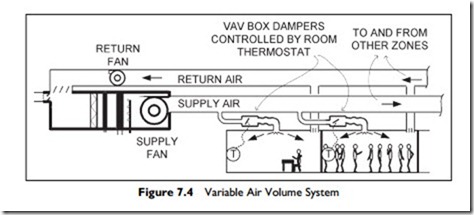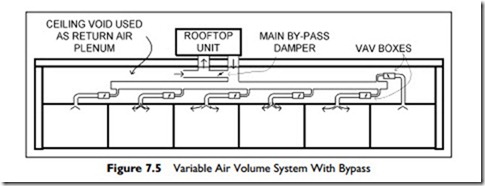Single-Duct, Variable Air Volume Systems
Buildings that are located in continuously warm climates, and interior spaces in any climate, require no heating, only cooling. For cooling-only situations, it would be ideal to supply only as much cooling and ventilation as the zone actually requires at the particular moment. A system that comes close to the ideal is the variable-air-volume system “VAV”.
The variable air volume system is designed with a volume control damper, controlled by the zone thermostat, in each zone. This damper acts as a throttle to allow more or less cool air into the zone. The VAV system adjusts for varying cooling loads in different zones by individually throttling the supply air volume to each zone. Regardless of the variations in the cooling load, a minimum flow of ventilation air is always provided and care must be taken to ensure that the required volume of ventilation air is provided.
In a VAV system, as the zone becomes cooler, the cooling load decreases and the cool airflow to the zone decreases. Eventually it reaches the minimum value necessary for adequate ventilation and air supply, Figure 7.4. When this
minimum airflow is reached, if the zone is still too cool, heating is provided by a thermostatically controlled reheat coil or a baseboard heater.
This means there may be some energy wasted in the VAV system, due to heating and cooling at the same time. However, this energy waste is far less than in the terminal reheat system, since the cooling ventilation air is reduced to a minimum before the heating starts.
The total supply-airflow rate in a VAV system will vary as the zone dampers adjust the flow to each zone. Therefore, the supply fan must be capable of varying its flow rate. The variation in flow rate must be achieved without allowing the duct pressure to rise excessively or to drop below the pressure required by the VAV boxes for their proper operation. This pressure control is often achieved by using a pressure sensor in the duct to adjust a fan-speed control unit. Similarly, the return fan is controlled to meet the varying supply-air volume.
There are other methods that are discussed in the ASHRAE Course, Fundamentals of Air System Design.
In systems where the fan speed is reduced to reduce the volume flow, the fan power drops substantially as the flow reduces. This reduction in fan power is a major contribution to the economy of the VAV system.
VAV systems may have variable volume return air fans that are controlled by pressure in the building or are controlled to track the supply-fan volume flow.
In small systems, the variable-volume supply may be achieved by using a relief damper, called a “bypass,” at the air-handling unit. The bypass allows air from the supply duct through a control damper into the return duct, as shown in Figure 7.5.
As the zones reduce their air requirements, the bypass damper opens to maintain constant flow through the supply fan. This arrangement allows for the constant volume required by the refrigeration circuit. For smaller systems, this method can provide very effective zone control without creating problems that may occur when the airflow is varied across the direct expansion refrigeration coil. Unfortunately, this system keeps the fan working at near full load.
VAV Advantages
Advantages of the variable volume system are the low initial costs and low operating costs. Initial costs are low because the system only requires single runs of duct and a simple control at the end of the duct. Operating costs are low because the volume of air, and therefore the refrigeration and fan power, closely follow the actual load of the building. There is little of the cool-and- reheat inefficiency of the reheat system.
VAV Problems
There are potential problem areas with variable air volume systems. These include: poor air circulation in the conditioned space at lower flows; dumping of cold air into an occupied zone at low flows; and inadequate fresh air supplied to the zone. Improved diffusers have made it possible for the designer to avoid dumping and poor room circulation. However, the problem of inadequate out- side air for ventilation needs additional care when the system is being designed.
For example, as we saw in the last chapter, in a constant volume system where all the zones require 20% outside air, setting the outside air to 20% on the main unit ensures that each zone receives 20% outside air. In the VAV sys- tem, one cannot set the outside air proportion. As the zone flows are reduced due to low thermal load, the proportion of outside-air-for-ventilation needs to increase. As a result, the outside-air volume must be maintained at all volume flows. This can be achieved in a number of ways, but the process requires a sophisticated, and potentially more expensive control system that is not required in constant volume systems.

